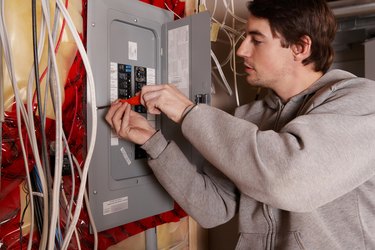Things You'll Need
Paper and pencil
Calculator
Access to devices to be powered by the subpanel

An electrical subpanel installs downstream from a home's main breaker panel. A subpanel is often installed in a barn, workshop, garage or other addition to a home. Subpanels are rated in terms of how much power they can safely monitor. In order to select the proper size subpanel, you must calculate the peak amount of power used by devices wired or plugged into the panel's circuits. The power consumed must be less than the maximum rating on the subpanel.
Calculating Wattage
Step 1
Identity the number of watts used by every wired-in electrical device that will be powered by the subpanel. Add all wattages to determine the power consumption of these devices. For example, if you have five 100-watt light fixtures and a 500-watt wired-in electric heater used regularly in a workshop, the total power consumption is 1,000 watts. Some of these devices may be rated in terms of amps used rather than watts consumed. We will tally those in the next section.
Video of the Day
Step 2
Identify any tools, appliances and other electrical devices that you will plug in and use on a regular basis in addition to the those that are permanently wired into the electrical circuits. A power-consumption sticker or graphic plate is affixed to each of these devices. Tally the wattages listed on these stickers or plates. If any of them is rated in terms of amps, save the amperages for later.
Step 3
Add the total wattage used by all the electrical devices. Divide the wattage by the voltage in the circuit. This answer is the amount of amps pulled by these devices. Returning to our example, if you have 1,000 watts of wired-in devices and another 1,200 watts pulled by a appliances such as a microwave, toaster and computer, the total wattage consumed at any moment in time is 2,200 watts. Divided by 120 volts in a standard household circuit, these devices consume 18.33 amps.
Step 4
To the previous amp total, add any amperages from devices for which power consumption is rated in amps rather than watts. For example, a contractor-grade 7 1/4-inch circular saw typically pulls between 12 and 13 amps. A heavy-duty drill is rated between 3.2 and 5 amps, and other stationary bench tools usually fall somewhere in between. If you have a furnace and any other electrical HVAC equipment such as a hot water heater and sump pump, be sure to include these machines in your tabulations. The result is total amperage needed for the subpanel
Some of these devices are rated in terms of peak amps, which the device draws when it is first turned on, and amps drawn under normal operation. The panel should be able to handle peak loads in order to create a margin of safety. For these devices, use the peak amps in your calculations.
Video of the Day